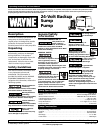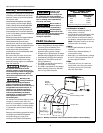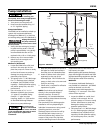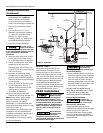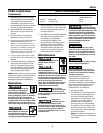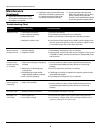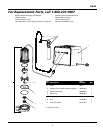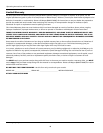
5
ESP45
www.waynepumps.com
1. Place battery box within six feet of
the sump and a 115 VAC separately
fused outlet. The outlet must be
protected by a ground fault circuit
interrupter (GFCI). The area must also
be clean, dry and well-ventilated.
2. Wave cardboard over batteries to
blow away any gas that may be
present.
3. Connect jumper wire between
batteries as shown on Figure 1.
4. Connect power wires from PS/BC to
battery terminals as shown in
Figure 1. Connect the red wire to
the unconnected positive terminal
of battery A and then connect the
black wire to the unconnected
negative terminal of battery B. The
yellow light should now be on.
5. Plug the pump and then the float
into the PS/BC. The connections are
marked.
6. Test pump operation by filling the
sump with water while the main
pump is unplugged. If the pump
operates properly, plug the PS/BC
into the GFCI protected outlet to
begin charging the battery.
NOTE: Protect electrical cord from sharp
objects, hot surfaces, oil and chemicals.
Avoid kinking the cord and replace
damaged components immediately.
Operation
Always disconnect the power
source before attempting to
install, service, relocate or
maintain the pump. Never touch sump
pump, pump motor, water or discharge
piping when pump is connected to
electrical power. Never handle a pump
or pump motor with wet hands or when
standing on wet or damp surface or in
water. Fatal electrical shock could occur.
Risk of electrical shock! Use a
GFCI receptacle to reduce the
risk of fatal electrical shock.
Cutting the cord or plug will void the
warranty and make the pump inoperable.
1. After installation, the backup pump
will start when the water level rises
above the depth that the primary
pump should start.
2. The PS/BC has a DC charger designed
to shorten the recharging time of
your battery, and to prevent
overcharging. In addition, the
control box has a time delay which
keeps the pump from repeated,
short cycles when it shuts off. This
time delay feature will allow the
pump to run 15 seconds after the
switch reaches the off position.
Maintenance
Unplug main AC pump and the
charger. Risk of electrical
shock!
Always disconnect the
electrical supply before
attempting to install, service,
relocate or per-form any maintenance. If
the power source is out of sight, lock and
tag in the open (off) position to prevent
unexpected power application. Failure to
do so could result in fatal electrical
shock. Only qualified electricians should
repair this unit. Improper repair could
result in fatal electrical shock.
Once a month,
check the condition
of the battery. In order to review the
battery condition, follow the steps that
are listed below:
BATTERIES
Dangerous
hydrogen gas can
be released from batteries while
charging. Sparks can ignite the gas in
an enclosed space. Wear safety goggles
when connecting batteries. Battery
connections should be made in a well-
ventilated area.
Working in the
vicinity of lead acid
batteries can be dangerous. Before making
connections or servicing the batteries, read
and follow instructions in all applicable
instruction manuals. To reduce the risk of
battery explosion, follow the instructions
in this manual and those published by the
battery manufacturer, as well as those of
any other equipment used in the
surrounding area.
If battery acid contacts your eye(s),
flush with cold running water for 10
minutes and seek immediate medical
attention. If acid contacts your skin or
clothing, wash immediately with soap
and water.
Never smoke or allow a spark or flame
in the vicinity of the battery.
Avoid dropping metal tools on the
battery posts because they may spark
or short-circuit the system or battery,
causing an explosion.
Follow battery manufacturer’s
maintenance procedures and
schedules. Be certain that the area
around the batteries is well ventilated.
Before servicing the batteries, blow
away gasses by waving a piece of
cardboard near the batteries.
1. Unplug the PS/BC.
2. For batteries with top caps that can
be removed, the electrolyte level
should be checked and filled to
manufacturer’s specifications. The
charge for each cell should be
checked with a hydrometer. A
specific gravity of 1.265 indicates
the battery is at full charge. If the
specific gravity of any of the cells
varies more than .050, the battery
should be replaced.
NOTE: An inexpensive hydrometer
can be purchased at an automotive
parts dealer.
PS/BC Installation
(Continued)
CHART 2 - PS/BC STATUS LIGHTS
LIGHT ON WHEN ACTION REQUIRED
Red Low Voltage or Blown Fuse Check Fuse or
Replace Batteries
Yellow Battery OK None
Green AC power on None



